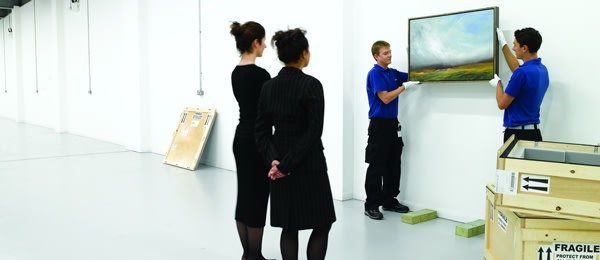
Every week, we'll be your guide as you navigate the world of buying art in our series, The Collector.
After the initial excitement of buying a work of art has passed, it's time to start thinking about your next steps. Handing your check over is just the beginning. There are important things to take into consideration when it comes to properly caring for the work as well as getting your legal and financial ducks in a row. Thankfully, there are a bunch of experts to help you through theses processes and it's just a matter of knowing who to turn to.
Documentation
There's a lot of paperwork that goes into the purchase of an artwork, and it's crucial not to lose track of it. Keep your invoice, receipt, and any other documentation you've received from the dealer all in one place that's secure and easy to pull up if needed. This kind of information is an important part of valuing the work if you ever decide to resell it, as well as for tax and insurance purposes. It's also a good idea to take photos and store them with the paperwork. Take a picture of the work as a whole, and some closeups to showcase the condition. If there are any worrying spots - fading or damage to the surface - be sure to snap that as well in case it starts to get worse. It also doesn't hurt to take a picture of any information on the back of the work. If you've bought a few pieces at once or are starting to grow your collection, you may also want to put all of this information in a spreadsheet or scan your documents to keep a digital record of your works all in one place.
Taxes
Depending on your state's laws, you may be responsible for all or some of the taxes that are due upon purchase of your work. There are also taxes to be taken into consideration if you're storing your art somewhere other than your home, or if you bought it elsewhere and are now bringing it to your home state. You'll want to check this out with an accountant or lawyer and, if you do owe taxes, you'll then need to have your work officially appraised to determine its value.
Insurance
Another important step is determining whether or not your new artwork is covered under any current insurance plans you have, like your homeowner's insurance. If it's not (and the more valuable it is, the more likely it won't be), you'll want to purchase separate insurance for the piece to protect it against damages or theft. Different plans cover different things so make sure you read the paperwork carefully and ask questions to know exactly what you're signing up for and if it's the best fit for your concerns. Insuring your work also requires getting an appraisal, and you'll need to do this with some regularity so that your insurance is reflecting the value of your work as accurately as possible.
Caring For Your Work
If you're hanging the work, there are steps to take to help preserve its condition for as long as possible. Keep it away from direct sunlight, which can cause fading, and don't hang it over a working fireplace, which can warp or dirty the canvas. Try your best to keep the humidity of the environment between 40 and 60% and the temperature between 50 and 70 degrees. You'll also likely need to occassionally dust the painting, and you should be careful to only use a soft artist's brush or cloth. If you'll be storing the piece, it will need to be packaged with materials to protect it from damages and humidity. Depending on the piece, this could include blankets, bubble wrap, mounting boards, or special boxes. All materials need to be acid-free. Once stored, it will also need to be kept in a similar environment as outlined above. The exact procedures for caring for your work will vary depending on various factors like the medium, surface, and age of the piece when you purchased it, and your dealer will be happy to go over the instructions with you or guide you to conservators that can assist you.
Taking these steps shortly after purchasing your piece may not be the most glamorous part of collecting art, but they will save you a lot of trouble in the long-run.